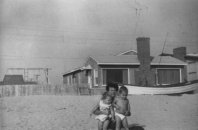
But wait... if you want to see my professional experience resume, it can be found right here on the internet, along with my amateur radio station page, my other hobby which is in the field of Human Factors, Aviation Safety, and Human Error. If that isn't what you want to look at, then browse another site I administer, the Pacific Seafarer's Net site which deals with our network of information trafficing between sailboats and other vessels on the high seas.
From the Beginning...
I was born in Santa Maria, California
on December 5, 1952. My father was a cattle rancher at the time,
and within a year we moved to the Gifford Ranch (relative of the media
famous Frank Gifford) which we owned at the time. While there, my
father Robert E. Reed Sr bought a beach front lot in Newport Beach,
California
for $5,000. He had the house built for a little over $10,000
which
gave us a beach front house in Newport at a bargain price. It
later
sold in 1976 for $180,000 and who knows what that piece of property is
worth now!

Initiation into the 1950's surfing
"Beach
Bum" lifestyle
Newport Beach was a dream place to grow
up, especially on the beach. I learned to swim in the ocean with
my mom. I learned to surf there and I still surf to this
day. Linda, my older sister by 10 years always came home with
high school stories and it is really interesting thinking back to her
being in high school between 1957 and 1960. I think I remember
her wearing saddle shoes, but I'm really not sure. Her boyfriends
had the cool cars for sure.
My sister Suzy, 1 year younger that me, was a great pal to grow up
with.
We did alot of stuff together on the beach. I learned boating,
sailing,
flying airplanes and many other things there. It was a superb
radio
reception location, so I would often grab the knobs of one of my dad's
short-wave receivers and explore the glorious wonders of world-wide
international
broadcasting and all the other stuff to hear. I could even
receive
WLS in Chicago at that location. It was really cool.
The location offered wide open beach area to learn kite building and
flying,
baseball on the beach, football, volleyball, unlimited opportunity for
play drama stuff for under-10 year olds like mock army battles and any
number of other fun things. We could camp in vacant lots
and
sometimes we got away with camping on the beach, but it wasn't legal to
camp on the beach after about 1957.
My father was not working by his own choice when we moved into our newly built house in '54, and at the time we could drive our Willys Jeep on the beach because it was legal then. He was able to spend allot of time with us doing fun things like building model planes, surfing and shaping surfboards. My dad began surfing in the early 30's during the depression, hitching rides and using scrapped together model T Fords to get to Corona Del Mar to live in the caves at China Cove for the Depression era summers. For him the Depression was a time of wonderful memories of the beach and surfing lifestyle. It was a perfect retreat from the troubled times. After moving back to Newport in '54, his enthusiasm for surfing was relit and we began living the dream life of a 50's era "surf bum" family. We spent countless days making surf trips up and down the Southern California coast to the great surf spots of the time including "Killer Dana" Point which is now a yacht harbor.
It was at Dana Point that I remember a number of visits to Hobie Alter's one-man surfboard shop. This had to be in about 1957. Whenever we went in there, Hobie was usually sanding and grinding away on a board with his respirator on, which left a great impression on me at my young age. My dad and Hobie and others would trade surfboard blanks, ideas, and stories of surfing spots and waves. Our own garage became a board building shop and I can still smell the resin and feel the itching of the fiberglass dust. The house is still there, and the concrete slab garage floor still probably has remnants of resin drops stuck it.
The Aviation Connection
The whole experience of learning the beach
lifestyle from my parents shaped the rest of my life. Because of
my father's history as a pilot before, during and after WWII, I
developed
an intense interest in airplanes and aviation by digging into his
scrapbooks
and boxes of photographs. He didn't fly from the time I can
remember
until I was about 12 years old, so as a small kid I was both mystified
and captivated by the magic of airplanes partly because I never flew in
one until I was about 10 years old. That was when my dad
and
I rode with the Mayor of Newport beach in his 182 to Salton Sea and
back,
stopping at Palm Desert airport. That flight was enough to stoke
me even more. I couldn't get airplanes off my mind for years
after
that. Suzy wasn't much interested in airplanes. She liked
other
things though. She spent alot of time with our mom.
It was a wonderful time in aviation in the late 50's and early 60's. We lived under the outside approach airway into LAX, and there were alot of DC-7's, Connies, Electras and DC-6's flying down the chute into the sequence to the airport. There was nothing like the thundering roar of 4 P&W R-2800's or Wright R-3350's augering their way through the sky. It wasn't quite the same when the jets started showing up, but I still had a kink in my neck over the years looking up. At the beach house there were always Coast Guard, Marine, and Navy planes flying low over the beach. Civilian planes were always doing the same. So I longed for the day when I could fly with my dad and maybe by myself. Heck, I still hadn't even seen my dad fly an airplane yet.
When I was about 13 my mom passed away after a long bout with stomach cancer. She spent most of her illness in the house and it was difficult at any age to deal with it while it was going on. We bought an 18 foot runabout inboard boat that we spent alot of time on, and we did alot of fishing on that boat. It was a way to escape from the ordeal going on at home. We never were gone very long on any day. But she never got better, only getting more sick all the time. She passed away at 47 years old in that house. It was January 20, 1965.
The "Post-Mom years"
In spite of the terrible experience of
the two years leading up to that date, the years following it continued
on a positive and fun track. It was a beach house in a great
town,
Newport Beach, California. My father had a strong determination
to
keep the family together and he was able to do just that. He was able
to
come home reasonably soon after we got home from school, and he worked
only 1 mile from our house. He was the city's Marine Safety
Director.
I learned to sail in Newport Harbor on alot of different saiboats ranging from Sabots to the Cal 30. I spent most weekend days and some weekdays out there on the bay sailing, and also we took the larger sailboats to Catalina 27 miles off the Southern California coast. When the surf was small or nonexistant, I would sail. When the wind was nil, I would surf. If niether was in the cards, I would watch and try to meet girls on the beach in front of our house. I would fly occasionally when the money allowed it.
We went places, we had some really fine summers, and I met my current wife at that time. She was 16 and I was 13. It was unusual, because she was hired by my father to keep watch on the house, add the lady's touch, and keep track of my sister Suzy and I during the summer months. Since she was a complete and total fox, I fell in love with here the minute I saw her. So there you have it. I fell in love with the governess/babysitter and ended up marrying her 15 years later. We never got romantically involved until late in 1976. More on that later.
I got to fly my first plane not long after mom passed away. It was a Cessna 120 that someone made to look like a 140. The guy who owned it took me up after talking to my dad. I was pumped! I got to take it through some shallow and tight turns in both directions and managed to keep altitude. The guy said I was a natural. It was really amazing!. It only made me more of an av-nut.
I made my dad take me out to Orange County airport and Meadowlark airport in Huntington Beach constantly just to watch the airplanes take off and land and listen to them on an old reciever with a slide rule dial. We judged every landing. We would walk around the airplanes and "kick tires". We would talk about maybe owning one someday. I liked theAeronca 7AC. We both liked the Cessna 170B. It was so great and such a cool way to spend time with Dad. Of course, I was always bugging him to get current again so we could fly together. It took years but he relented. Teenagers can be so persuasive!
Probably a year after my first flight at the controls, my dad decided to get current again with his ticket. I remember going up with him for the first time and it confirmed to me that he really could fly! He got checked out in a V-tail Bonanza which was fun. I just didn't like the swing-over yoke. We rented Cessnas and Cherokees out of Orange County airport. I was loving it!
At 15 I began taking flying lessons. On one flight before my solo, I remember we took my wife (just a friend back then) who weighed under 110 lbs, which allowed her to ride in the jump seat in the baggage compartment of the Cessna 150. We went to Palm Springs and back. I remember the thing climbed horribly with that much weight in it.
Getting in the Way
Other things got in my way. It was
my freshman year in High School. I had soloed in the plane went
on
to just over 22 hours, and I was on the high school water polo
team.
It was 1969. At that time I stopped flying until I picked it up
again
in 1976. I think I lost enthusiasm for flying
because
I began feeling the delayed effects of watching my mom pass away the
way
she did. So I strayed away from aviation and went to surfing and
other things. I went though high school, and had a mediocre first
two years there while my last two years ended up being fun and
energetic
with good grades. I made honor roll in my last year both
semesters.
I went to Orange Coast College to begin and Aviation Technology major there. It was the fall of 1971. I didn't last long at OCC because I made the wrong choice to quit school and work full time. I had just spent the summer as a lifeguard and while doing that I worked nights as an EMT for a local ambulance service which seemed exciting because I was working with some lifeguarding friends. It went on for a couple of more years and became too much to take. I found myself in the middle of too many tradgedies and had to leave the business.
I then took a job with the City of Newport Beach working with other lifeguards and olympic waterpolo players in an unlikely occupation, that of a "Refuse Crewman" as they called it, a job commonly referred to as a trash man or garbage man. But think about it. It was Newport Beach, and the trash in Newport is awesome! People throw away money and any number of unbelievable things there. I never bought anything for my house in the two years I did that job. I later changed to a cross position of splitting time between wrenching on equipment there and crewing on a one-man refuse truck. I did this until October 1975.
I then decided to get back to school and take up where I left off. I started over at Orange Coast College in the Aviation Technology Program and finished it this time. I left the "refuse" job and got a new job at a school district as a custodian which allowed me to go to school full time and work full time. It was a blurred memory of intense activity at that time, but I met back up with my "babysitter" Patrice Michelle Domecq and I went head over heels for her again. This time we got serious and we've been together ever since.
A New Career Path
It was time to begin a new career
path.
In 1978, after two and a half years in the Av Tech program, I graduated
second highest grade in the Av Tech program. I was somewhat
burned
out from the intense hours I was putting in, but I could now work a
more
normal schedule. I had been supporting my last year of school by
working nights full time at Parker Hannifin Aerospace in Irvine,
California
as an aerospace hydraulics test and assembly technician. It was a
good job but I needed to leave to take a great job working on corporate
jets at Long Beach and Orange County airports. I started working
at Martin Aviation on Lears and Citations in 1978. I was totally
loving this job even though the hours were long. I had the job I
dreamed of at last; working on million dollar corporate jets.
My boss decided to leave Martin and he headed to another operation up at Long Beach and a bunch of us followed him there. It was the same type of work. We had 4 Lears, 2 Citations and some large Cessna twins. In the same corporate house we also had a scheduled airline running three Grumman Mallard G-73's. They were wonderful airplanes made post-war, and I fell in love with them too. I actually gained favor with the crews and became the night lead maintenance tech for the airline, and I split time between the airline and working on the corporate jets. It was so much fun even though I was headed for a burnout. I even found some time to work next door on some old DC-6's and Lockheed Loadstars, but my lady-to-be-my-wife started protesting a little about the time I was spending working so I scaled back a bit.
We took in Muhammad Ali's Jet Commander at the time, and after we had them for a customer for awhile, they offered me a director of maintenance position to start a corporate flight department for them. We were beginning preparations for the transition when their finance manager, Harold Smith, ran off and disappeared with all of Muhammad Ali's money and the whole thing collapsed with the pilots losing their jobs and the Jet Commander being parked indefinately. But, I still had a job at this fixed base operator (FBO).
Off to New Zealand
After about a year and a half of this,
I ended up burning out mildly, and I took a 3 week vacation and left
town.
I came back refreshed and went back at it. So then it
happened.
We decided to get married in 1981 and we did it on the beach in
Newport.
After getting married, I resigned my job(s), and Patrice and I flew to
New Zealand for a 3 month honeymoon. It was fabulous, and we will
never forget the times we had there. I bought a surfboard in New
Zealand and had the best surfing time of my life up to then. The
guys I met surfing there were watermen of the highest caliber.
Patrice and I spent 6 weeks of the
three
months hitchhiking almost 800 miles round trip from Auckland to
Invercargill
and back, taking some of the famous back packing hikes offered in the
south
of the South Island. We lived out of our back packs, and we made
so many new friends in our travels. I tried to get a job
with
Air New Zealand while we were there but they were in a hard financial
situation
and had a hiring freeze on at the time. Oh well...
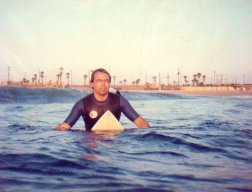
This is a good place
to reflect on the day's work at the hangar...
Eventually, we had to go back home and go back to work. I immediately got a job at Tallmantz Aviation at Orange County Airport going head strong back into corporate aircraft maintenance. Tallmantz had a wide variety of aircraft to maintain, too many to mention here. I went to some maintenance schools including Lear 35 school and some others. We had some Falcon 10 and 20's we maintained and inspected too. We had a number of Citations and King Airs too. It was a very busy place. Sometimes if it got slow, we went over and worked on the two B-25 Mitchells that Tallmantz used in their photography work. The thundering Wright R-2600's were wonderful to have beat your ears and brains out sitting between the prop blades just inches from your head. It was a truly wonderful experience for a 27 year old to be able to do this in the 1980's. We had a blast working the the B-25's.
Crossroads
I worked for two years at Tallmantz when
3 things came my way. I had been going to night school
getting
electronic certifications, and after securing those so I could go into
the avionics field, I was offered a job as an avionics technician,
another
offer as a corporate flight department director of maintenance, and the
third offer came from an engine manufacturer, Avco Lycoming Turbine
Engine
Division out of Stratford, Connecticut. I had a decision to make
and I went with Avco Lycoming.
It was a good decision. I assumed
a position in an uncovered and unsupported area of the United States
with
a new product line they had, the LT-101 turboshaft helicopter engine
being
fielded in the Bell 222, Aerospatiale AS-350D A-Star, and the
Messershmitt-Boelkow
BK-117. It was an immature engine that did not have the benefit
of
going through a war to work out the bugs with military dollars. The
LT-101
was marketed to the commercial public too soon and reliability issues
became
rampant. It was a baptism by fire for me. All my customers,
most of them being heavyweight corporate customers like Hughes Aircraft
Radar Group, Rockwell International, and Southern California Edison
among
others, were incensed and fuming about how terrible the engines were in
both performance and reliability. The upside was that I was
getting
to see alot of the world because of the lack of outside support for the
product. I made numerous trips to Hawaii, Japan, Fiji, and to all
parts of the mainland United States.
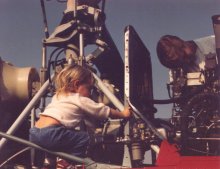
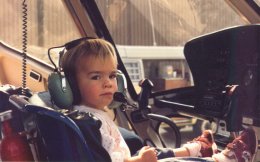
My daughter Allison
would
often help us with the critical aspects of getting the bird ready
so that she could fly
it first.
I found that I had a skill in dealing with irate corporate customers. Walking into a meeting room as the object of abuse for a board of aviation department heads was something that I very much enjoyed, strange as it sounds. Often times we showed up for customer meetings together with our (Lycoming) engine program directors as a planned meeting designed by the customer to slam us. I enjoyed observing our high powered executives dealing with theirs. Other times the meetings were planned short notice, with only myself representing the manufacturer. They usually went as well as could be expected from our side of the table. The main thing is that nothing stupid be said to the customer that would either anger them or reveal something about our actions that would anger them. Most of the time they were politically delicate situations.
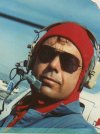
Another time to
reflect..right
AFTER building the engine and BEFORE
strapping the
helicopter
it is now installed in to your waist....
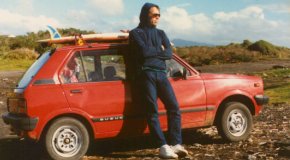
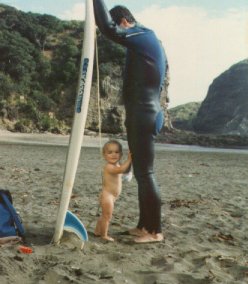
Left: The Subaru
hatchback
we rented in New Zealand. This was in the Taranaki region in
New Plymouth.
Right:
Daughter Allison is telling me where the best waves are. This was
at Piha
in the Auckland area
of New Zealand's North Island.
In 1986 Patrice and I went back to New
Zealand on a 5 week vacation. I took a surfboard and we also took
Allison, of course. Patrice was pregnant with my son Cameron at
the
time. Instead of hitchhiking this time, we rented a car and
visited
some of the same people we visited and met the first time. It was
really a fantastic vacation, and again I tried to get on with Air New
Zealand
but again they were on a downturn with a hiring freeze. I even
went
to a customer there just to see their operation and meet the
people.
You see, Avco was just on the verge of being aquired by Textron, so our
management advised us to take advantage of all our vacation since
Textron
would not allow us to accrue a bunch like Avco did. I took all 6
weeks at once since I had the opportunity to be covered by another
rep.
New Zealand was just as fabulous as it was the first time.
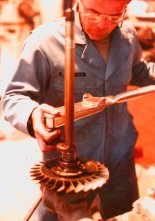
45 pound-feet on the
"Jesus Nut" of the engine, the power turbine retention nut.
It is only 3 threads
wide. Originally it was all that held the turbine in the
engine. Later,
we added a retention device to the front of the shaft to hold
it there if the nut
came
undone.
I digress.. Back to the
politically
delicate situations. That was only one aspect of the job. I
often broke down and assembled engines by myself, but in most cases I
observed
and directed disassemblies and assemblies. Because of my
wrenching
background, I assisted in engine removals and installations since it
would
speed my departure from the site. It was frowned upon by my
superiors,
but it lowered the cost to the customer and made me available for the
next
disaster.
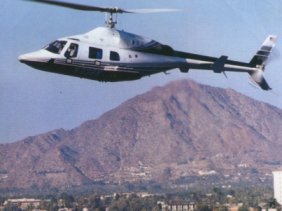
Knoell Homes' Bell 222B
in Phoenix. Their corporate flight department was
always a joy to work
in. This one replaced their original 222A.
Accident Investigations
The most interesting and enjoyable part
of my job with Lycoming was that of an aircraft accident investigator
representing
the manufacturer. A group of us tech reps and several project
engineers
took the course by University of Southern California. I had
participated
in several investigations prior to certification by USC, but the class
was really helpful and fascinating.
During the course, I had a good friend killed in an in-flight disintegration of an A-Star helicopter while transporting a gunshot victim to a hospital. It took them about 2 weeks to get all the pieces located in a hangar for the post-crash investigation and I represented Lycoming on that one. The parts were scattered over a 1 square mile area because the aircraft scattered at 5500 feet AGL. That was probably my most interesting case, because of the total destruction. It became obvious in the first 2 hours of being with the collected wreckage that the swashplate had siezed, causing loss of control and causing the main rotor blades to dive into the structure while the pilot tried pulling up-collective. That investigation will stick with me for as long as I live.
There have been other very interesting ones. I had a number of investigations that involved people who I had become friends with during my dealings with them on the field service side of the job. That was not easy but I always kept quite about my aquaintance with fatal vicims of air crashes to avoid problems. It didn't seem to be a problem to objectively investigate an accident when I knew the victims.
I would often recieve a call to go at
about
1:00 pm to be on the east coast at 8:00am the next morning. That
always involved scrambling quickly and travelling the rest of the day
and
night to get there on time. Investigations were challenging and
very
interesting. I miss that part of that job more than anything
else.
I enjoyed my FAA and NTSB contacts.
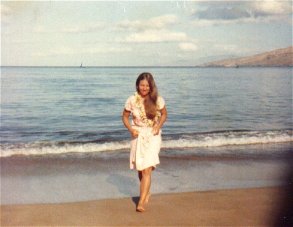
My lovely wife Patrice
on a Kihei, Maui, beach walk in front of the
hotel during a business
trip to support one of my customers. (I paid
her way on the trip...)
The trips to Hawaii were mostly service
calls and customer calls, but about 4 trips were accident
investigations.
Our prime operator was on Maui and Kauai, but the majority of calls
were
to Maui. I had a surfboard stored at the operator's location, so
I could go to the best surfing spot after working with the customer
which
was absolutely great. What could be better than surfing in Hawaii
on a paid vacation? The customer was a high volume tour operator
running high operational duty times, and they provided a wealth of
information
on engine problems and reliability issues. We were able to use
them
to determine what was and what wasn't a problem, and their ability to
run
op times up so quickly meant alot of trips out there for me to assist
in
getting the engines turned around quickly during hot section, accessory
gearbox and on-condition inspections.
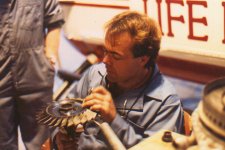
Turbine blade trailing
edge
cracks were a constant issue with this
single-piece wheel
design.
We later went to a fir-tree blade root
insertable blade wheel
that
fixed the problem but started others.
Another interesting facet of the job
with
Lycoming was in legal testimony as a fact witness in lawsuits against
the
company. I found out that what management told me concerning what
I said in my job reports was very true; namely, "watch out what you say
in those reports. They could come back to haunt you later in a
lawsuit..."
Probably the most interesting was when Kurt Russell/Godie Hawn sued us
for a service difficulty experienced when he bought an aircraft.
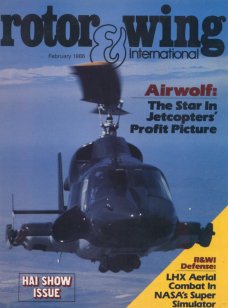
The Bell 222A
"Airwolf".
The Bell Helicopter Van Nuys service center crew
kindly referred to her as
"Airdog"...Actually it's two engines were not bad.
Another interesting customer we had was the operator of the Bell 222 used in the series "AirWolf". Sometimes I would visit the set while they were shooting an episode which was always fun to see. The helicopter wasn't used that much after the first year of the show, and it was sold to an operator in Germany for corporate use.
The United States Coast Guard was the customer I enjoyed doing field service work with the most. They weren't concerned about dollar cost of fixing an engine on-site, and I was able to be directly involved in helping them solve a horrific downtime problem with the HH-65 Dolphin fleet caused by repeated engine removals for small problems that could have been fixed in the field. Coast Guard policy had them removing the engines and sending them to Elizabeth City N.C., which is their overhaul site. The engines were going back there for any small problem that, in the majority of cases, could be fixed at the station location overnight or in 2 days. In 1988 and '89 I was assigned to Elizabeth City to observe the operation and then later assigned to accompany the Coast Guard's Dolphin program chief engineering officer to various air stations and train crews on engine disassembly and repair for the most common issues they were having. It was tremendously rewarding to be able to contribute to getting the Dolphin program on-track and relieve the burdon on Elizabeth City. I had 7 air stations assigned; 1) Barbers Point, Hawaii 2) Humboldt Bay, Ca. 3) North Bend, Oregon 4) Astoria, Oregon 5) Port Angeles, Washington 6) Los Angeles, Ca. 7) San Diego, Ca.
Humboldt Bay, in my home turf, was really fun to work with. The guys were really cool and good at what they did. I often went over there just to chat over morning coffee with the chief engineering officer for the station. We solved alot of problems for the USCG and we learned alot together. I had 3 friends killed out of Humboldt Bay in a Dolphin in a CFIT accident during a foggy morning on a search and rescue mission where they flew the aircraft into a cliff. They were fine young men.
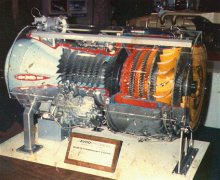
The Textron-Lycoming
AL5512 for the Boeing 234 heavy lift helicopter
After 4 years with Lycoming, I was trained on and worked with other product lines. The T5508D, the T55-712 and AL5512 engines were awesome. The AL5512 was the commercial variant of the T55-712 and produced 4435 shaft horsepower single engine rating. My customer for that engine was Columbia Helicopters. They ended up owning the entire world fleet of Boeing 234 helicopters for their logging operations. They resulted in many trips to Portland, Oregon.
The time came, as all good things do, for the job to end. In 1992 the military cut back severely which affected Lycoming very negatively. We had major cutbacks in the Boeing Chinook helicopter program and the M1 Abrams tank engine program production run of 10,000 engines came to an end at the same time. The company layed off 7000 employees in Stratford and they layed off 75 percent of the field service representatives which included me. It was a tough blow to take but it worked out in the end as all things like that do. I had two young children coming up and this allowed me to work locally in the Northcoast California area and to always be home in the evening with the kids during a crucial time in their lives.